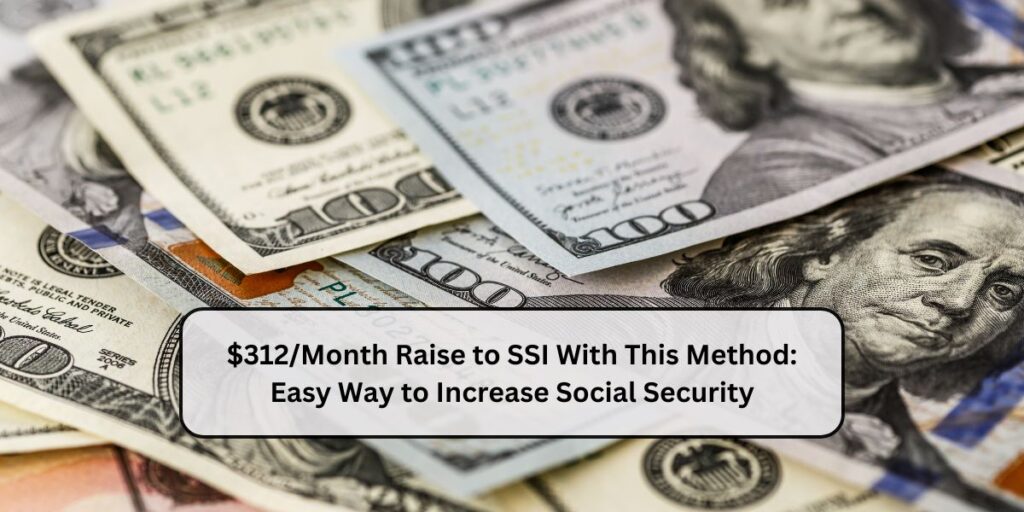Discover comprehensive details on $312/Month Raise to SSI with this straightforward method. SSI is a crucial federal program providing monthly financial support to low-income adults and children with disabilities, ensuring they can cover essential living expenses. While SSI benefits are fixed based on individual circumstances, there are effective strategies available to enhance monthly payments for those living below the federal poverty line. Explore this article further to learn about maximizing your SSI benefits and securing financial stability.
$312/Month Raise to SSI With This Method
Supplemental Security Income (SSI) serves as a crucial financial lifeline for low-income individuals, including both adults and children with disabilities. Currently, the maximum federal benefit stands at $943 per month. This amount, however, often proves insufficient in covering essential living expenses.
The discussion around increasing SSI benefits frequently centers on the goal of raising them to align with the federal poverty line. In 2024, this benchmark hovers around $1,255 per month for individuals. Achieving this adjustment would mean a notable raise of approximately $312 per month for beneficiaries currently receiving the maximum benefit.
| Important Links |
|---|
| SASSA Pension Dates July-August 2024 |
| Centrelink $1,500 Payment 2024 |
| Canada Minimum Wage 2024 |
This proposed increase aims to better support recipients in meeting their basic needs, reflecting ongoing efforts to enhance financial stability and inclusivity for vulnerable populations.
Easy Way to Increase Social Security
Boosting your Social Security benefits isn’t straightforward due to the program’s complexity and the factors influencing benefit amounts. However, there are strategies to potentially increase your monthly Social Security income by up to $312 for SSI.
- Work History Impact: Your benefit amount is calculated based on your average monthly earnings over 35 years of work. Working fewer than 35 years can reduce your monthly payment, so maximizing your work history can lead to higher benefits.
- Maximize Income: Higher earnings during your career translate to higher Social Security payments. Negotiating higher wages, changing jobs for better pay, or taking on additional work can increase your average income, thereby boosting your benefits.
- Delay Claiming Benefits: You can begin receiving Social Security as early as age 62, but your benefit amount will be permanently reduced. Waiting beyond your full retirement age (up to age 70) increases your benefit by a certain percentage annually. This delayed claiming can significantly enhance your total benefits.
- Spousal Benefits: If you’re married, you may qualify for spousal benefits based on your spouse’s earnings record, even if you haven’t worked much yourself. These benefits can be substantial, particularly if your spouse has a higher income.
- Monitor Earnings: Regularly reviewing your earnings record with the Social Security Administration ensures accurate benefit calculations. Reporting any discrepancies promptly helps maintain the correctness of your benefits assessment.
While these strategies can potentially increase your monthly Social Security income, it’s important to note that Social Security alone may not cover all your retirement expenses. Exploring additional retirement savings avenues such as IRAs, 401(k)s, or private investments can supplement your income effectively.
All We Know
The proposed $312 per month increase in Supplemental Security Income (SSI) is crucial within the context of Social Security beneficiaries. While SSI benefits receive annual cost-of-living adjustments, these adjustments may not always keep pace with inflation.
SSI includes work incentives aimed at encouraging beneficiaries to engage in the workforce. It’s important that increased benefits do not disincentivize work activity. However, the long-term sustainability of SSI must be carefully weighed alongside any potential benefit increases.
Discussions surrounding the possibility of a $312 per month raise in SSI benefits highlight the potential to enhance financial security for low-income individuals with disabilities. This adjustment could significantly alleviate financial burdens and improve the overall quality of life for these vulnerable populations.

